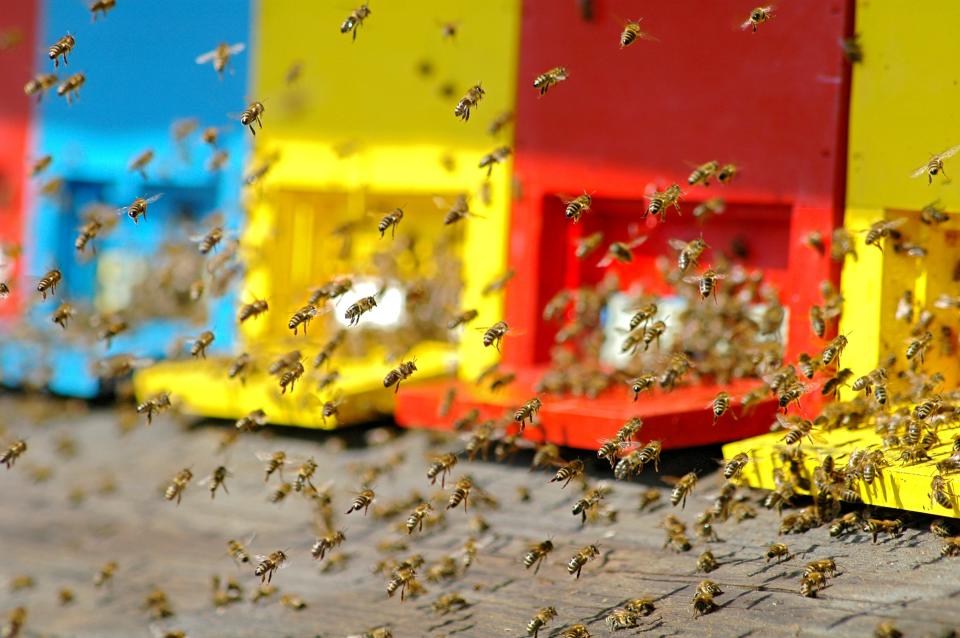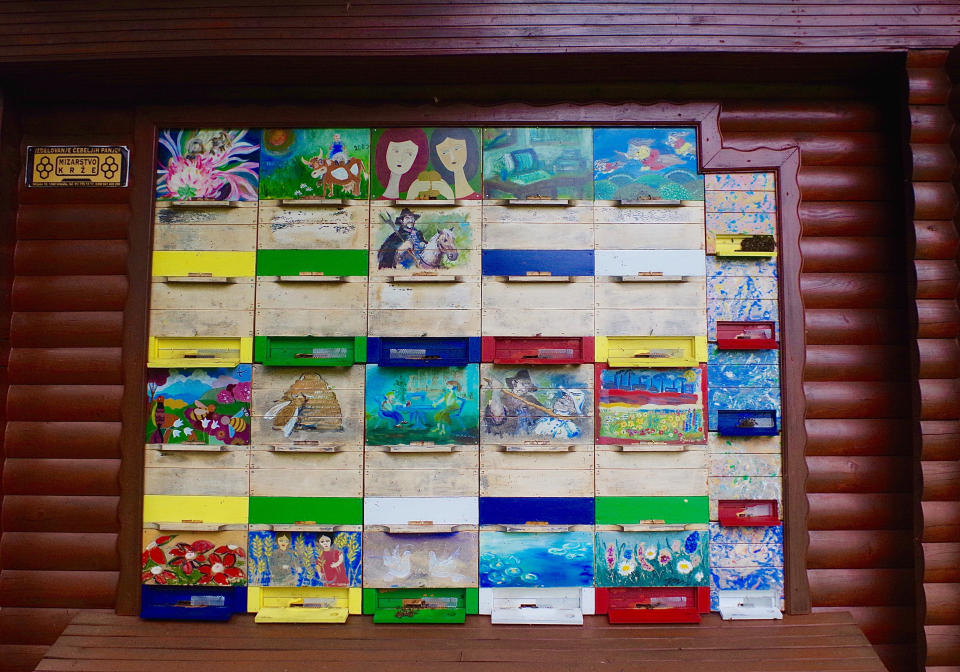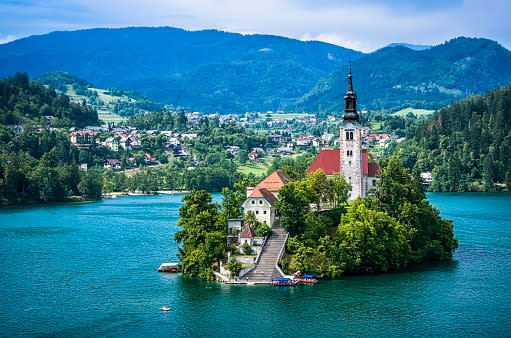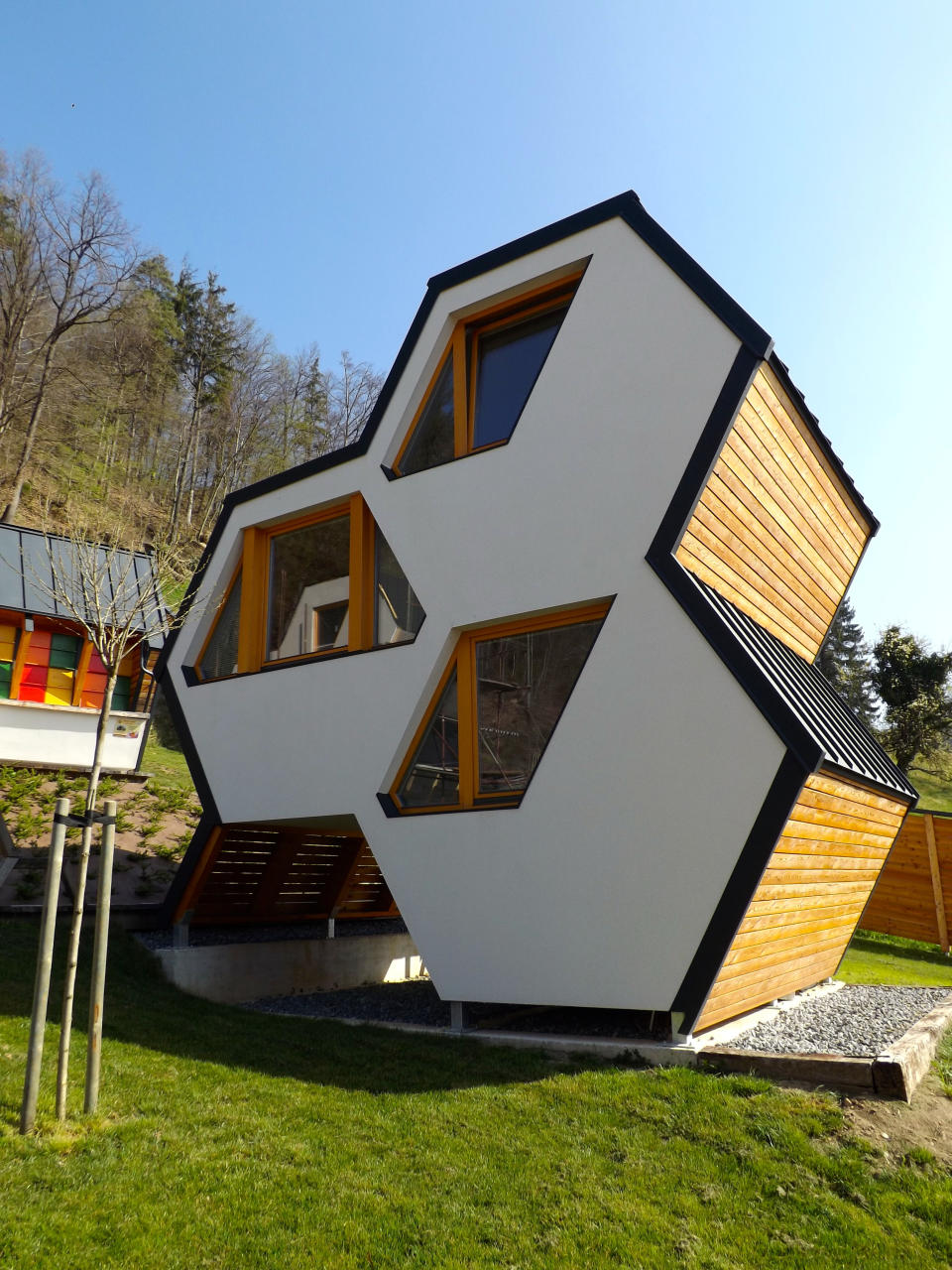The surprising nation that loves bees more than anywhere else in the world

The door opens with a quiet click, something catching on the lintel – and we emerge onto the roof. It is a sparse, unfurnished space, although the Hotel Park has future plans for it – an open-air bar, perhaps, which would take advantage of the view that fans out on all sides. There, to the north-west, are the Julian Alps, still slightly frosted in the late spring sunshine. Below, bathed in the same glow, is Ljubljana, all orange tiles, pastel-hue churches and winsome spires – the River Ljubljanica slipping woozily through its centre.
And there, in a corner, is the hotel’s current use for its upper level. Two squat beehives. A cloud of the insects shakes and shimmers in front of the access slits – causing Gorazd Trusnovec to smile. A stocky, unshaven man, he goes under the title “President of the Ljubljana Urban Beekeeping Association”. And today, he is feeling particularly proud of these twin outposts of his empire – which stretches to 24 hives, rented to keen apiarists across the Slovenian capital. He installed them on this roof last year, despite reservations.
“I was sceptical as to whether you could put hives at this height,” he muses, scratching his chin. “So was the hotel manager. But by last July, this was my best site in the city, in terms of honey. The bees do not seem to struggle to reach this elevation – this 13th floor.”

It is, if you can forgive the pun, a sweet deal. The Hotel Park gets to serve its own honey at breakfast – an extension of its bid to be a “green” accommodation option, with its ecolighting and charging point for electric cars – Trusnovec gets an experimental location for a business that began as a nostalgic urge, but has become a passion. The amount of honey produced by such hives does not, he says, match the effort needed to create a new one. “But working with bees brings me peace of mind,” he says. “My grandmother had a hive. The smell of honey extraction was incredible. I forgot it for 30 years – then it came back to me in a Proust-like sensation, this aroma from my childhood. I started to look at raising bees in the city. I put a hive on my apartment balcony.” He spreads his arms. “Here I am.”
Rather than the hard conventional hive Slovenia deploys clusters of mini-hives that resemble rows of colourful PO boxes.
This fascination may sound remarkable, but it is not unusual in Slovenia, where hives and honey are practically a religion – there are around 90,000 beekeepers in a population of just two million. Indeed, beekeeping is a prime part of the identity of a country that needs all the distinguishing characteristics it can grasp. It has only existed in its modern form since 1991 (after centuries of being co-opted into Austro-Hungary and Yugoslavia) – and a glance at the map shows it squished into central Europe, fringed by bigger, more feted neighbours. Quirkily, it takes the shape of a chicken running across a farmyard, the head pecking east at Hungary, one foot planted onto Croatia in the south-east, another kicking at Italy in the south-west, its back brushing Austria’s Alpine underside. It is, beyond its capital, a semi-forested realm, and bees thrive within it. It even has a distinct strain of the insect – Carniolan bees, which are valued for their non-aggressive nature and team ethic.
This national affection flickers at the pretty heart of Ljubljana. It is visible by the river on Medarska Ulica – “Honeysellers Street”. Admittedly, this thin lane is no longer devoted to such a trade, but the adjacent square of Pogacarjev Trg has picked up the baton, with stalls selling jars of gold-amber and bottles of potent farm-made honey liquor. It is there too, on Copova Ulica, where the wrought-iron canopy above the 1904 Mestna Hranilnica bank features a bee, a symbol of hard work reaping its own rewards – and at the National Museum, on Muzejska Ulica, where a bee motif floats over the right-hand entrance door.

Fifteen miles north-east, in the village of Lukovica, matters take a more formal tone. The headquarters of the Slovenian Beekeepers’ Association crowns a low hill – and takes its job seriously, with a laboratory for testing independent producers’ honey to make sure of the requisite quality.
May 20 has long been a red-letter date in Slovenia, saluted with honey-related festivities as the birthday of Anton Jansa – a beekeeping pioneer, born in nearby Breznica (35 miles north-west of Ljubljana) in 1734, who developed such expertise that he was summoned to the Habsburg court in Vienna to impart it. Three centuries on, the association has been petitioning the UN to make this Slovenian hurrah a global affair – and looks to have met with success. And exactly a year tomorrow – May 20, 2018 – is likely to be the first “World Bee Day”, official rubber-stamp permitting.
The 25 places in Eastern Europe you must see in your lifetime
An oddity to add to the calendar? Not at all, says the association’s Peter Kozmus, leading me outdoors to show me Jansa’s legacy. The Slovenian beehive looks like no such thing. Rather than the hard, covered apparatus that is the conventional hive – where honeycomb frames are removed by pulling them up and out – Slovenia deploys clusters of mini-hives that resemble rows of colourful PO boxes. Bees enter via narrow grooves at the front – the frames are removed horizontally and from behind, in a room inside the structure. This, Kozmus explains, is less stressful for bees – and less likely to result in stings for keepers.
But the Slovenian beehive goes beyond pragmatism and into folklore. So much becomes clear in Radovljica. This small town, 30 miles north-west of Ljubljana, is an embodiment of Slovenian beauty, pitched alongside the early currents of the Sava, that major river of the Balkans – with mountains in the distance, and a medieval kernel cocooned at its core.
Within, the Museum of Apiculture dissects the meaning and methodology of the country’s beekeeping – not least the ornate painted panels that traditionally adorn every mini-hive. There are long rows of them here, many dating to the 18th century. Some are religious (the Virgin Mary blessing a swarm), some romantic (images of wives and girlfriends), some superstitious (devils driving beer carts), some happy documents of local life (ploughs and oxen, schools in session, weddings, festivals).

Alongside, information boards detail the range and habitat of the Carniolan bee (it is also found in Croatia, Hungary and Bulgaria). And outside, on Linhartov Trg, the end product comes into focus at Pension Lectar, a hotel-restaurant where flavoursome “honeybread” biscuits are made in a downstairs museum – and punchy honey beers are served to diners.
If this is the final act of the pollen-gathering process, then it is fascinating to see the start of it. A short hop away, on the other side of the Sava in the hamlet of Selo pri Bledu, Blaz Ambrozic is an evangelist who has turned his farm into an apicultural temple, giving tours and advice to would-be beekeepers – as well as to visitors who want to buy his honey. He throws me a net-veil protective hat as soon as I arrive, so that I can stand closer to his main hive – and even encourages me to place tentative fingers into its belly. Its Carniolan residents, preoccupied, are unmoved. Ambrozic beams like a proud father. “Every bee has a specific role,” he explains. “Some are collectors, others guard-dogs or kindergarten nurses. If our governments operated as efficiently as bee colonies, we would see a lot more done.”
The world's best wildlife holidays: an A-Z guide
Their importance, he stresses, cannot be underestimated. “Bees are under threat. This is why we have been campaigning, in Slovenia, for World Bee Day. If bees are not here, then there is less pollination – and less food. With less food, there is starvation – and war. It’s that simple.”
His enthusiasm goes beyond good practice into the newer area of “apitherapy”. He is not alone in this. Across Slovenia, beekeepers have been modifying their hives to make them more interactive. In Ambrozic’s case, he has expanded his largest hive into an L-shape, with a padded bunk-bed in the added corner. Lie down here, and you can peer through glass and watch the bees as they buzz in and out. He also hands me a tube, with a breathing mask attached, which is plugged into the hive – it is designed to let visitors inhale the warm, nectar-heavy air within. I cannot say I feel any instant health benefits in doing this – but 10 minutes gazing at these tireless creatures as they flit in and out of base has an almost hypnotically calming effect.
Some have taken this concept of the bee as a purveyor of relaxation even further. I travel east, to the picture book town of Mozirje, where Beeland is a flash of ingenuity – not, as its name suggests, an unlikely honey-themed funfair, but an inventive nugget of accommodation set in a leafy valley.

Here, too, a hive has been converted for apitherapy. But the star attraction is a quartet of honeycomb-shaped chalets, each with three levels – an en-suite bedroom; a kitchen and living space; a top-floor sauna and hot tub.
They are as cosy as they are clever, and the pastoral vista through the window supplies an extra visual compliment, wildflowers swaying in the breeze.
It is tricky to say whether bees or tourists will appreciate this panorama more – but both can surely draw inspiration from it.
Getting there
Wizz Air (0911 752 2257; wizzair.com) flies to Ljubljana from Luton four times a week – from £52 return.
Touring there
Slovenian specialist ApiRoutes’ (00386 2229 8360; authentic-routes.com) offers a four-day “Slovenia Eco Tour” which includes a visit to a beekeeper, for €660 (£564) per person (no flights); Blaz Ambrozic offers farm tours for €4 per person (kralov-med.si).
Staying there
Hotel Park, Ljubljana (hotelpark.si). Double rooms from €92, with breakfast.
Pension Lectar, Radovljica (lectar.com). Double rooms from €77, with breakfast.
Beeland, Mozirje (apartmajimozirje.si). Honeycomb chalets from €110 per night.

